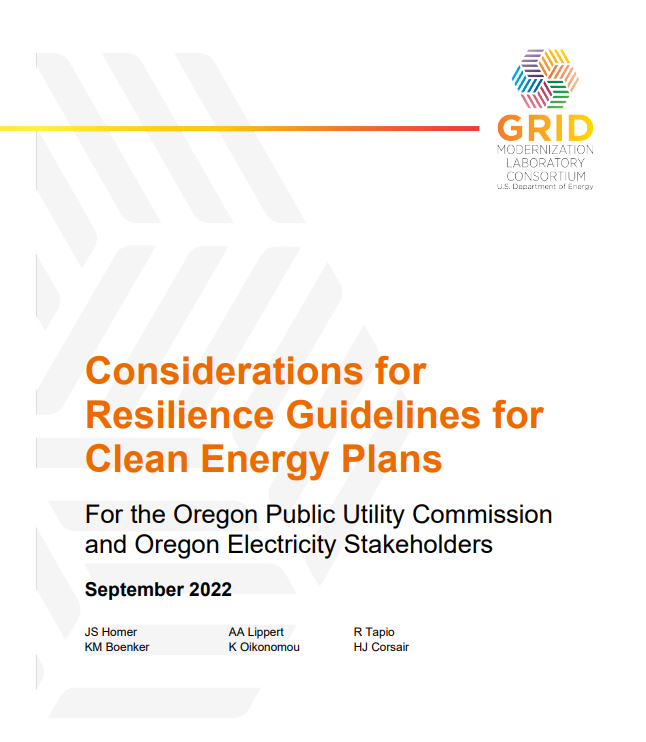PNNL Supports a Resilient Power Grid for Oregon
PNNL publishes Considerations for Resilience Guidelines for Clean Energy Plans report

Juliet Homer, PNNL
(Photo by Andrea Starr | Pacific Northwest National Laboratory)
A PNNL-led report published in September 2022 will help the Oregon Public Utility Commission (PUC) with planning for a resilient power grid as the state of Oregon moves forward with 100 percent clean electricity by 2040.
Considerations for Resilience Guidelines for Clean Energy Plans was prepared for the Oregon PUC by a project team led by Pacific Northwest National Laboratory (PNNL) Systems Engineer Juliet Homer as part of the Department of Energy’s (DOE’s) Grid Modernization Laboratory Consortium (GMLC). The report is already garnering appreciation by the Oregon PUC.

According to Oregon PUC Chair Megan Decker, “The report captured succinctly and clearly the state of resiliency analysis and measurement across our industry, and effectively connected those best practices with the layered clean energy and community and equity concerns of Oregon’s legislation.”
The report is in response to laws passed by the Oregon Legislature in 2021, that in addition to requiring 100 percent clean electricity by 2040, requires the Oregon PUC to develop risk-based resilience guidelines for clean energy plans. The Oregon PUC will use the report to better understand what it means to plan for resilience, including important factors like costs, consequences, outcomes, and benefits. Equity is also a major focus for Oregon energy stakeholders and was included in the report.
Homer said, “Resilience is increasingly important, subsequently, how utilities are planning for that is increasingly important. This report is a guide for PUCs related to risk-based resiliency planning, while taking into consideration the importance of equity for how different communities respond to power outages- what their tolerance is in these types of situations.”
Report highlights include a collection of innovation and best practices related to resilience and utility planning for resilience. For example, the report captures the best practices California is implementing based on what they’ve learned from recent wildfires. Best practices were also considered when discussing cost-benefit analysis, prioritizing potential resilience investments, planning for equity, and practical considerations for achieving resilience through distributed energy resources. The team’s report outlines four key steps in resilience planning analysis: defining resilience goals, developing system and resilience metrics, characterizing threats and their probabilities and consequences, and evaluating effectiveness and cost of alternative resilience measures for avoiding or mitigating threats.
Homer added, “This report hits the sweet spot for PNNL. We’re leaders in energy planning, resilience, and energy equity. We understand the difference between reliability and resilience and can put forth recommendations that benefit communities while helping them understand options in clear terms and the best approaches. Essentially, resilience, grid planning, and equity need to be strongly considered when planning for the whole community. We’re glad this report is helpful for Oregon, and we think it can be helpful to other states as well.”
Oregon PUC staff members Heide Caswell and Caroline Moore also addressed the recommendations in the report and said, “The work prepared by the GMLC supports Oregon as it moves toward a cleaner energy future. They did a great job understanding our needs and knowledge gaps and produced a report that hit the mark between well researched technical findings and accessible information for Commission Staff and our broad stakeholder group. It was informative and actionable!”
The project is part of the State Technical Assistance to Public Utility Commissions Project which GMLC leads on behalf of DOE. Established in 2014, GMLC aims to accelerate the modernization of the nation’s power grid so it can accommodate more clean energy resources in a resilient, reliable, and secure way. The GMLC is partnership between the DOE and 14 national laboratories.
Additional team members include Karyn Boenker (PNNL), Kostas Oikonomou (PNNL), Rebecca Tapio (PNNL) Alice Lippert (Argonne National Laboratory), and Hope Corsair (Oak Ridge National Laboratory).
Published: February 21, 2023